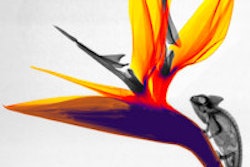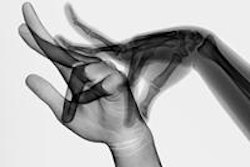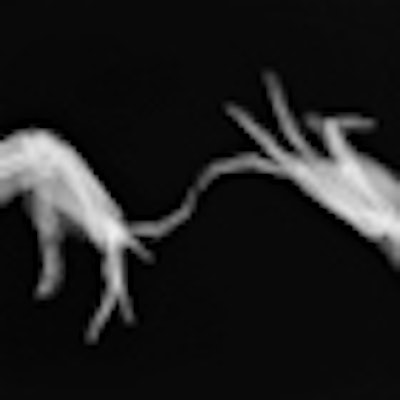
Do x-rays make the personal impersonal, stripping out our humanity to examine our inner structures? If so, French artist Marc Ferrante has perhaps recaptured it. Collaborating with puppeteers and other hand artists, he's created a collection of approximately 100 hand radiographs, exploring "whether life can be breathed into these images."
His "Jeux de mains," or Hand Plays, project consists of six series of images, ranging from scans of hands casting shadows of creatures, to images of translucent skin without bone, to representations of the space between two hands. The images are displayed in light boxes and as print photography.
"I merged the x-ray imagery with the elements that constitute the opacity of a living being, everything that radiography generally negates -- shadow, reflection of light, imprints and fingerprint or the skin itself, people's mania or research on the hand's ability to grasp the void or time," he wrote on his website.
 Shadow play series. © Marc Ferrante.
Shadow play series. © Marc Ferrante.Ferrante worked with a wide range of individuals on the project, from radiologists, radiologic technologists, and surgeons to puppeteers, marionettists, and dancers.
"X-ray imaging crushes any kind of space and expression," he told AuntMinnieEurope.com. "I had to find people with special abilities, such as specific morphologies or a certain flexibility in their hands."
Such flexibility is on display in the "hand dancing" series, which shows hands in seemingly unattainable positions, reflecting the movement of a puppeteer warming up, for example, or of different types of dance.
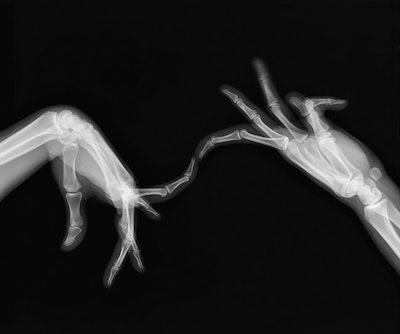 Hand dancing series. © Marc Ferrante.
Hand dancing series. © Marc Ferrante.The hand, in general, is a recurring feature of Ferrante's work, he said. Regarding radiology, imaging the hand offers a contradiction between the connectedness and vitality that it can represent, and the disconnectedness of the anatomy as viewed on an x-ray.
"The hand clutches, touches, caresses, expresses, whereas radiography is a screen that separates the subject from his own body, allowing the doctor to take over," he wrote. "Moreover, x-rays only show a partial image of the self. While it miraculously penetrates the body and reveals its anatomy or constituent parts, it also masks the vibrant complexity of the being. It removes the skin and everything else that makes up one's personality, life, or feelings."
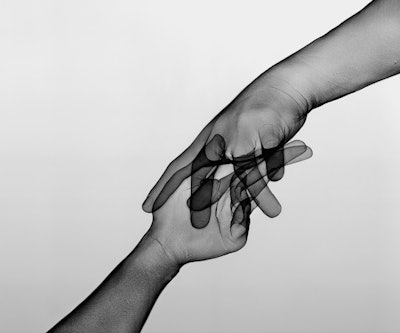 Skin series. © Marc Ferrante.
Skin series. © Marc Ferrante.For the "object theater" series, hands were scanned with a range of puppets -- from the more traditional variety to the modeling of a chicken or crab. The coverings represented a type of "second skin," according to Ferrante, providing both an interesting variety of materials to scan, as well as the opportunity to play with the items' meanings or connotations.
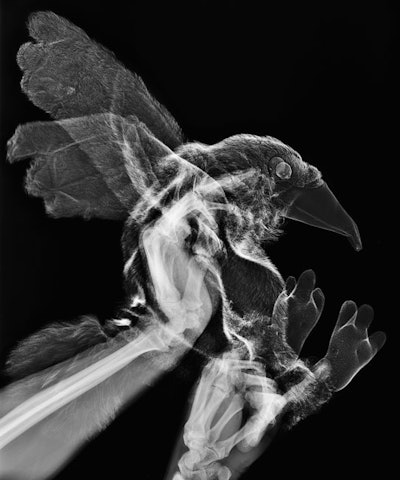 Object theater series. © Marc Ferrante.
Object theater series. © Marc Ferrante.All images were created using digital x-ray systems from Fujifilm Medical Systems, Ferrante said, without alteration with programs such as Photoshop. Much of the effect comes from trial and error and preparation before scanning even begins; for example, by filming and studying a participant's hand movements beforehand.
Aside from use of the digital x-ray system, the rest is "all old tricks: nothing digital, everything was ready before going to the radiologist," he said. "This is why the result is often surprising and very different from the high-tech medical imaging done by computer. Otherwise, I never say how I work because the image must keep its magic. All I can say is that, for example, it took six months of work to bring up skin without bones."
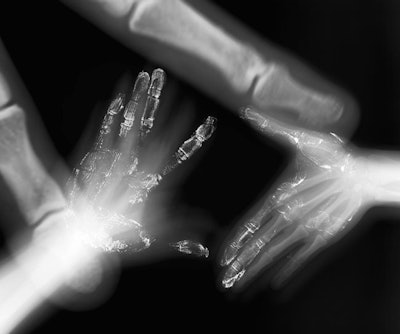 Modified presence series. © Marc Ferrante.
Modified presence series. © Marc Ferrante.Part of the project was also to examine radiography in the context of its influences, according to Ferrante, mixing the present with the technology's past. The images show what the technology can now inspire, but they also reflect artistry that surrounded radiography's past, such as photograms, pantomime shows, puppetry, or other theater.
"Every series [of Hand Plays] gives a different and supplementary definition of radiography, and inscribes it as a dynamic medium in historic and artistic multiples," he said.
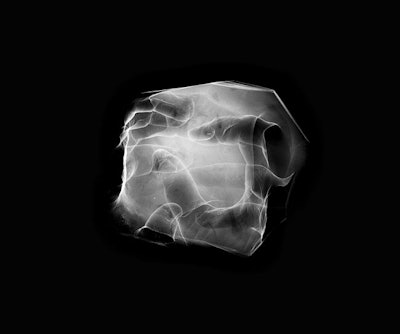 Ergon series (space between hands). © Marc Ferrante.
Ergon series (space between hands). © Marc Ferrante."Medical imaging conveys the hopes and fantasies of our society because it reflects the latest scientific and technological innovations, while reminding us of our human condition and our fragility," Ferrante noted. "X-rays remain the scene of diseases and symptoms, but also unearth the beliefs of our particular time period because they are not only a scientific discovery, but also a cultural invention."
The Hand Plays images have been shown in several venues, most recently in October at the University of Strasbourg, but also at the Centre d'Art Nei Liicht in Dudelange, Luxembourg; the Centre Culturel André Malraux (CCAM) in Vandoeuvre-lès-Nancy, France; and the Centre Wallon d'Art Contemporain - La Châtaigneraie in Flémalle, Belgium. The project can be viewed at marcferrante.com.






